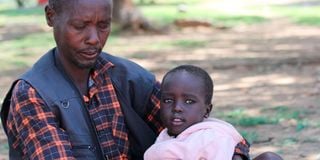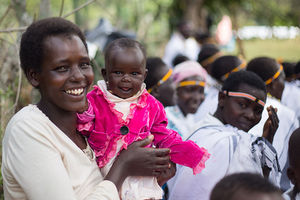The forgotten burden of paediatric Kala-azar

Mr William Lumuget with his five-year-old daughter who is suffering from Kala-azar.
What you need to know:
- Children usually face greater risk of infection, illness, and death from infectious diseases than adults, yet every year, they face debilitating illness or die due to a lack of appropriate paediatric medicines.
- In drug development, children have long been an afterthought. Clinical trials of treatment formulations for children may be delayed for years following trials in adults, or never happen at all.
Chenang’at Chelime tries to smile but her face is masked in pain. She has an abnormally bulged abdomen and her pale body shows the extent to which the disease has taken a toll on her.
She is seated next to her father William Lumuget, who is in deep thoughts. The five-year-old Chelime is a visceral leishmaniasis patient at Kacheliba Sub-County Hospital in West Pokot.
For months, the father has been moving from one hospital to another in search of care but could not get the correct diagnosis. The girl ended up getting treatment for non-existent diseases.
For 180 kilometres, Mr Lumuget trekked with his sick daughter from Turkwel, Isok Sub-County in Kapenguria to receive treatment at Kacheliba Sub-District Hospital, which is one of the few hospitals that offer this kind of treatment free of charge. Visceral leishmaniasis (VL), popularly known as Kalaazar, is the second deadliest parasitic disease after malaria and is transmitted by the bite of a female sand-fly.
Kala azar is one of the 22 neglected tropical diseases (NTDs) that affects more than 1.7 billion people globally mainly from resource limited settings.
It comprises about 40 per cent of the global NTDs burden in Africa. Out of the 22 Neglected Tropical Diseases recognised by the World Health Organization (WHO), Kenya is endemic to 19 of these.
At the hospital where Chenang’at is, half of the Kalaazar patients are children under 15.
The effects of neglected diseases in children contribute to stunted growth, cognitive impairment, inability to consistently attend school and malnutrition. They lack an appetite for food.
Children usually face greater risk of infection, illness, and death from infectious diseases than adults, yet every year, they face debilitating illness or die due to a lack of appropriate paediatric medicines.
In drug development, children have long been an afterthought. Clinical trials of treatment formulations for children may be delayed for years following trials in adults, or never happen at all.
“Nothing pains a parent more than not being able take the pain of your ailing child,” says Mr Lumuget, a father of 10.
Chenang’at is receiving a treatment made up of two daily injections given for 17 days. When Healthy Nation visited her, she received her eighth injection and had 26 more to go. She has to spend another 13 days at the hospital.
Chenang’at’s father will stay with her at the hospital until her last injection.
“As I stay behind with my child, I am hopeful that she will recover. I know soon there will be a shorter treatment for Kala-azar that does not require hospital admission,” he says. The impact of the disease is not only felt by the patient but also his family as the cost burden is beyond just the hospital bill.
It becomes a tough choice between buying food for the family and seeking treatment. For the affected breadwinners in the home, the result is social stigma, and it becomes difficult to provide for their families. Mr Lumuget, who rears cows and goats back home and sells them to provide for his family, had to hand over his job to one of his sons who now has to miss school.
“The diseases affect families economically, socially, physically and psychologically. When one is unable to provide for their family, there is a repeated cycle of poverty, which further contributes to the challenges of elimination,” said Simon Bolo, head of Leish Access at Drugs for Neglected Diseases initiative (DNDi).
Some progress has been made in finding treatments for children affected by NTDs. In 2022, DNDi and its partners concluded a clinical trial for a new treatment for leishmaniasis. Children were shown to respond very well to this new treatment and will particularly benefit from it. For an NTD such as sleeping sickness, a clinical trial for a single-dose paediatric formulation of acoziborole is ongoing.
There is still more to be done to find an effective formulation that targets children affected by VL and other neglected diseases. However, research activity dedicated to preventing and treating these diseases often lags behind. Certain NTDs are particularly under-represented in paediatric research when compared to adults.
Although there have been advancements in the control of NTDs with the World Health Organization noting that 47 African countries have already eliminated at least one NTD, elimination of these diseases globally will not be achieved if new tools for children are not found.
“Clinical research that ensures new treatments are safe and effective for children is crucial because children are not small adults; they need medicines in appropriate doses as they grow as well as drug formulations that are adapted for their age,” says Dr Monique Wasunna, Director Drugs for Neglected Diseases initiative (DNDi) Africa Regional Office.





